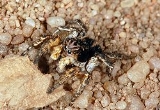
Aelurillus v-insignitus
Encyclopedia
Aelurillus v-insignitus is a species
of jumping spider
.
for "signed", because of the white chevron on the back of the male spider, which is in the form of the letter "V". This letter was originally spelled one v above another V, which could also be interpreted as a double V or W, but usually is interpreted as "V".
.
Species
In biology, a species is one of the basic units of biological classification and a taxonomic rank. A species is often defined as a group of organisms capable of interbreeding and producing fertile offspring. While in many cases this definition is adequate, more precise or differing measures are...
of jumping spider
Jumping spider
The jumping spider family contains more than 500 described genera and about 5,000 described species, making it the largest family of spiders with about 13% of all species. Jumping spiders have some of the best vision among invertebrates and use it in courtship, hunting and navigation...
.
Appearance
The male has v-shaped rows of hairs on its head and a pronounced white median stripe on its abdomen. The female is mottled brown. The spider can reach a length of 4–7 mm (0.15748031496063–0.275590551181102 ).Name
Insignitus is LatinLatin
Latin is an Italic language originally spoken in Latium and Ancient Rome. It, along with most European languages, is a descendant of the ancient Proto-Indo-European language. Although it is considered a dead language, a number of scholars and members of the Christian clergy speak it fluently, and...
for "signed", because of the white chevron on the back of the male spider, which is in the form of the letter "V". This letter was originally spelled one v above another V, which could also be interpreted as a double V or W, but usually is interpreted as "V".
Distribution
A. v-insignitus occurs in the Palaearctic. It is the only Aelurillus species that occurs in northwestern EuropeEurope
Europe is, by convention, one of the world's seven continents. Comprising the westernmost peninsula of Eurasia, Europe is generally 'divided' from Asia to its east by the watershed divides of the Ural and Caucasus Mountains, the Ural River, the Caspian and Black Seas, and the waterways connecting...
.

